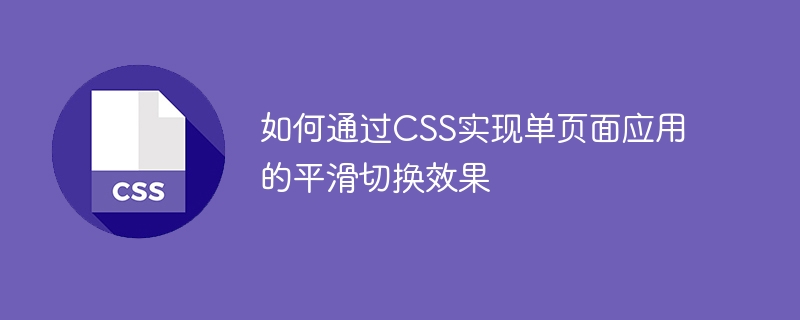Home >Web Front-end >CSS Tutorial >How to achieve smooth switching effect of single-page application through CSS
How to achieve smooth switching effect of single-page application through CSS
- 王林Original
- 2023-10-18 12:16:411276browse

How to achieve smooth switching effect of single-page application through CSS
In modern Web development, single-page application has become a popular development model. When users perform different operations in a single-page application, the content of the page will switch smoothly, giving users a good user experience. This article will introduce how to use CSS to achieve smooth switching effects in single-page applications, and provide specific code examples.
1. Use CSS animation to achieve smooth transition
CSS animation is a technology that achieves dynamic effects by specifying animation key frames. To achieve a smooth switching effect in a single-page application, we can use CSS animation to achieve the fade-in and fade-out effect of the page content.
First, we can define a CSS class to represent the entry effect of the page. For example:
.fade-in {
animation: fade-in 0.5s ease-in;
}
@keyframes fade-in {
from {
opacity: 0;
}
to {
opacity: 1;
}
}In the above code, we define a CSS class named fade-in and use the fade-in CSS animation. The animation starts from opacity of 0 and gradually increases to 1, achieving the fade-in effect of the page.
Next, we can define a CSS class to represent the leaving effect of the page. For example:
.fade-out {
animation: fade-out 0.5s ease-out;
}
@keyframes fade-out {
from {
opacity: 1;
}
to {
opacity: 0;
}
}In the above code, we define a CSS class named fade-out and use the fade-out CSS animation. The animation starts from the opacity of 1 and gradually decreases to 0, achieving the fade-out effect of the page.
2. Add CSS classes when switching pages
In actual use, we can monitor the user's page switching operations through JavaScript and add the corresponding CSS classes when switching pages to achieve smooth switching. Effect.
For example, suppose we have two pages, page1 and page2. When the user switches from page1 to page2, we can add the fade-out class to page1 and the fade-in class to page2 when switching. In this way, when the page is switched, page1 will gradually disappear, and page2 will gradually appear.
The specific code is as follows:
// 监听页面切换事件
function switchPage(pageId) {
var currentPage = document.querySelector('.page.active');
var nextPage = document.getElementById(pageId);
// 添加页面切换动画类
currentPage.classList.add('fade-out');
nextPage.classList.add('fade-in');
// 在动画结束时移除动画类并切换页面
setTimeout(function() {
currentPage.classList.remove('active', 'fade-out');
nextPage.classList.add('active');
nextPage.classList.remove('fade-in');
}, 500);
}In the above code, we first obtain the currently active page and the page to be switched to. Then, add the fade-out class to the current page and the fade-in class to the page you want to switch to. After the animation ends, we remove the animation class and switch the active page to the next page.
3. Summary
Through CSS animation, the smooth switching effect of single-page applications can be achieved, giving users a better user experience. We can achieve the fade-in and fade-out effect of page content by defining entry and exit animation classes and adding corresponding classes when switching pages. The above is the specific sample code on how to achieve the smooth switching effect of a single-page application through CSS.
I hope this article is helpful to you, and I wish you success in developing single-page applications!
The above is the detailed content of How to achieve smooth switching effect of single-page application through CSS. For more information, please follow other related articles on the PHP Chinese website!

